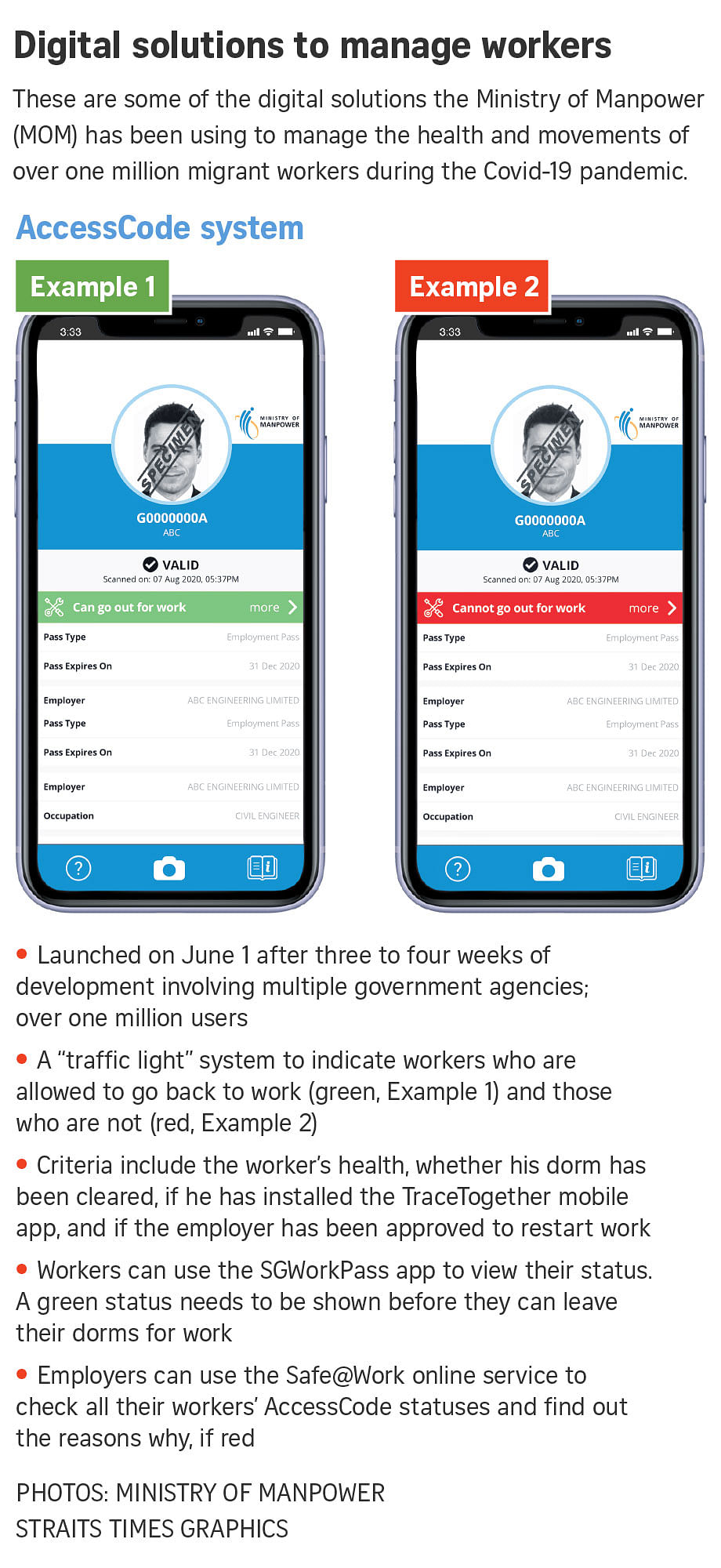As the economy and travel gradually restart, migrant workers re-entering both the country and the workforce pose potential Covid-19 risks. To address this, the authorities have turned to digital technology, using tools like apps and wearable GPS devices to keep track of their health and movements.
Senior government officials told The Straits Times that such technological solutions have led to great savings in manpower and resources, and it would be otherwise unthinkable to handle the vast numbers and logistics involved.
MONITORING DEVICES
As Singapore gradually reopens, the effort to keep infections low starts at the borders.
From 11.59pm on Monday, inbound travellers, with some exceptions, would have started wearing electronic devices to ensure they serve their 14-day mandatory stay-home notice (SHN) properly.
The Ministry of Manpower (MOM) issues one device for work pass holders and their dependents staying outside dedicated facilities, while the Immigration and Checkpoints Authority (ICA) announced last week that it will be issuing a different set for other travellers.
MOM's device is basically a smartwatch that alerts the ministry if its wearer leaves his or her place of residence. Once a worker clears immigration, officers tag them with it and make sure it is functional, after which the device is locked and cannot be removed until the SHN ends.
Although the ICA and MOM devices are both worn on the wrist and serve similar functions, they do so in different ways.
ICA's wristband device uses an app and another "gateway" device that must be plugged into a power socket at the residence. It uses Bluetooth signals, and alerts the authorities if the distance between the wristband and gateway at home gets too large, but cannot relay the exact current location of its wearer.
MOM's device works on its own without needing an app or an additional device. Unlike ICA's wristband, it uses GPS and 4G technology and can technically track the wearer's specific current location.
The smartwatch has other features, including a heartbeat sensor, allowing MOM to track the worker's health. As is the case with the ICA device, any attempt to tamper with the smartwatch or remove it will trigger an alert to the authorities.
Last week, an ICA spokesman said the two devices were separate solutions, but this is not due to differences in operational needs. He said MOM and ICA would assess the suitability of their respective devices in time and a decision will be made on any changes for operational needs.
Mr Don Yeo, senior assistant director in MOM's foreign manpower management department, said the main purpose of MOM's device was for it to be a standalone tool that could monitor workers round the clock.
The device significantly reduces the amount of manpower needed to monitor workers, he added. "With our current modus operandi, we call the worker about once a day (during the stay-home period). But with the watch, if the wearer is compliant, we need to do only one or two calls for the entire 14 days."
Mr Yeo said no data is stored on the device. Any sent back to MOM's servers is encrypted, and will not be retained beyond six months from the end of the SHN in most cases.
Within 24 hours after his SHN ends, the worker goes to a return point where the device is removed and disinfected for future use.
While Mr Yeo could not share details on the cost or number of devices, he said development started in May, and they were manufactured by a third-party vendor according to MOM's specifications.
TRACKING HEALTH, MOVEMENT
With testing completed for all of the 323,000 migrant workers, the authorities have put in place several safety measures to make sure their return to work is not marred by a spike in Covid-19 cases.
These measures, however, also mean a great deal of coordination behind the scenes - both in terms of the movement and health of workers inside dorms and between numerous government agencies.
MOM launched the FWMOMCare mobile app on May 18 to monitor workers' health, said Mr Sing Khang Leng, the ministry's chief information officer.
The app is used by over 414,000 workers - the majority of whom reside in dorms - to report their health status to the authorities, and also to scan QR codes at different locations, such as within dorm rooms, to report their whereabouts.
Apart from registering their temperatures, it asks workers if they have symptoms like shortness of breath or runny nose, and tracks their oxygen levels and heart rate. If unwell, the workers are prompted to use a teleconsultation service run by the Health Ministry, typically available within half an hour. The dorm operator and the worker's employer are also informed, said Mr Sing.
New features have been gradually added. For example, since July 23, the app can display electronic discharge memos for workers who have recovered from Covid-19. Issued by MOH, the memo is protected from tampering by digital certification using blockchain technology from local firm Accredify.
RESUMING WORK SAFELY
The FWMOMCare app is complemented by a massive digital system used to track the work status of over one million workers.
Called AccessCode, the "traffic light" system, as Mr Sing described it, gives a green status for workers who are allowed to return to work and red for those who are not.
On the front end, the process is simple enough. Workers flash the SGWorkPass mobile app and are allowed to leave their dorms for work if it has a green AccessCode status.
Their status is also checked when they use FWMOMCare to scan a unique QR code in their dormitory rooms before leaving for their workplaces. Separately, MOM launched the Safe @ Work online service for employers to check the status of all their workers.
But this is possible only because massive coordination is taking place behind the scenes between multiple government bodies, easily involving over 100 officers.
The system pulls together numerous criteria, including the worker's health, whether he has installed the TraceTogether mobile app, whether his dorm has been cleared of Covid-19, and whether his employer has been approved to restart work. The last involves the Ministry of Trade and Industry and sector agencies like the Building and Construction Authority and the Economic Development Board.
To develop the app, MOM worked with the Defence Science and Technology Agency and GovTech, making use of an existing government computing cloud to securely handle the data. It took about three to four weeks of development before the system was launched in early June.
Mr Sing said that there are "a lot of moving pieces" and ultimately all parties - including employers and dorm operators - need to play their part. "As much as we want to automate many of these processes, the reality is that there are certain gaps that still happen," he said.
These include things like the accuracy of data, such as the residence and other details of the worker.
"If you pump in bad data, you get bad outcomes. The system is only as intelligent as the data you put in," he said, adding that MOM officers are constantly cleaning data even as they improve the system.
Mr Yeo said that without technology, it would have been "humanly impossible" to manually coordinate the thousands of workers staying in the dormitories.
"It would be totally unsustainable and unrealistic to compile the data from temperature checks and clear workers to leave the dorms for work manually. So if we did not have a tech solution, I can't imagine what would happen," he said.



Correction note: This article has been edited for accuracy.












